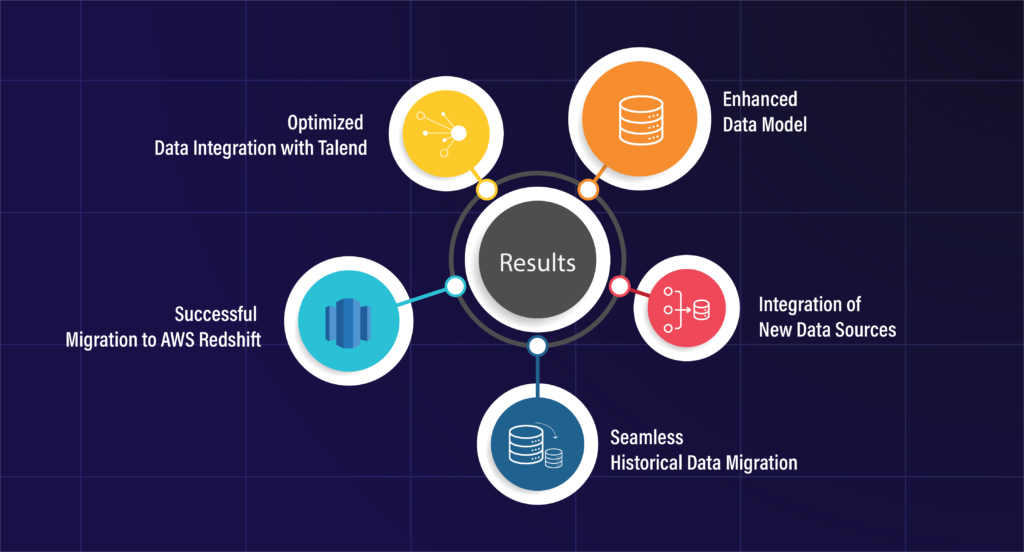From On-Premises Data Warehouse to Redshift Cloud Data Warehouse Migration for Yum Brands!
Project Overview:
In collaboration with YUM Brands, an eminent titan in the global fast-food sector, we undertook a transformative endeavor to revolutionize their data warehouse infrastructure. This ambitious project was focused on migrating their existing on-premises Netezza framework to the Redshift cloud data warehouse by Amazon Web Services (AWS). Additionally, it necessitated the comprehensive transition of data integration logic from IBM DataStage to Talend, marking a significant leap towards modernizing YUM Brands’ data architecture. This strategic overhaul was designed to augment flexibility, minimize operational costs, and utilize Talend’s sophisticated features for data processing and integration, all while providing the unparalleled scalability and agility of the AWS cloud platform.
Challenges
The pivotal challenge of this project involved several critical components aimed at transforming YUM Brands’ data management capabilities and infrastructure:
- The primary task was to migrate the existing on-premises Netezza data warehouse to the Amazon Web Services (AWS) Redshift cloud data warehouse. This move was essential for modernizing YUM Brands’ data architecture, enhancing flexibility, reducing costs, and leveraging the AWS cloud’s scalability.
- An integral part of this transformation was to redesign and enhance the data model to support both current and future reporting and analytics needs. This step was crucial for ensuring that the new system could accommodate evolving business requirements and data strategies.
- The migration of historical data up to the specified cutoff date posed a significant challenge. This process needed to be executed with precision to ensure data integrity and continuity for YUM Brands’ operations and insights.
- Another complex aspect of this project was the migration of all data integration processes from IBM DataStage to Talend. This transition required a deep understanding of both platforms to ensure that the logic and functionality of data integration were not only preserved but also optimized for the new environment.
- Additionally, the creation of new data pipelines to integrate additional data sources into the Redshift environment was a crucial challenge. This step was necessary to enhance the data ecosystem with broader insights and to support the diverse analytical needs of YUM Brands.
Each of these challenges required a meticulous approach, combining strategic planning, technical expertise, and innovative thinking to ensure a seamless transition and the realization of YUM Brands’ future-facing data strategy.
Solutions
To address the multifaceted challenges presented in the transformation of YUM Brands’ data management and warehouse infrastructure, a comprehensive, multi-step solution strategy was implemented:

Migration to AWS Redshift:
- Conducted a thorough assessment of the existing Netezza infrastructure to understand the schema, data volumes, and integration points.
- Designed a detailed migration plan to transition to AWS Redshift, ensuring minimal downtime and data integrity. This plan included environment setup, security configurations, and scalability considerations.
- Utilized AWS’s database migration service (DMS) and schema conversion tool (SCT) for a seamless migration, ensuring that data was accurately transferred and that the new cloud infrastructure leveraged Redshift’s performance and scalability features.
Data Model Enhancement
- Engaged with key stakeholders to identify current and future reporting and analytics needs, translating these into requirements for the data model.
- Redesigned the data architecture to not only support existing reporting needs but also provide scalability for future data sources and analytics capabilities.
- Implemented data governance and quality frameworks to maintain the integrity and accuracy of data within the new model.
Historical Data Migration
- Developed a phased migration approach for historical data to manage the volume and complexity, ensuring continuity of operations.
- Employed robust data validation and reconciliation processes to guarantee data accuracy and integrity post-migration.
- Established cut-off dates and transition plans for each phase, facilitating a controlled and orderly migration process.
Migration of Data Integration Logic to Talend
- Analyzed existing data integration processes in IBM DataStage to identify and document the logic and transformations applied.
- Reconstructed the data integration workflows in Talend, optimizing for performance and making use of Talend’s advanced features for data processing and ETL (extract, transform, load) operations.
- Conducted extensive testing to ensure that the migrated processes in Talend produced identical outcomes to the original DataStage processes, ensuring a seamless transition.
Creation of New Data Pipelines:
- Identified additional data sources critical for YUM Brands’ expanded analytics and reporting capabilities.
- Designed and implemented new data pipelines in Talend, incorporating data ingestion, transformation, and loading strategies tailored to the characteristics of each new data source.
- Ensured these pipelines were scalable, efficient, and integrated seamlessly with the Redshift data warehouse, enhancing the overall data ecosystem.
Throughout this project, a focus on collaboration, stakeholder engagement, and rigorous testing was maintained to ensure the solutions not only addressed the immediate challenges but also laid a foundation for YUM Brands’ future data strategy and analytics initiatives.
Results
The comprehensive strategy and meticulous execution of the project to transform YUM Brands’ data infrastructure yielded significant results:

Successful Migration to AWS Redshift
The transition from the on-premises Netezza system to the AWS Redshift cloud data warehouse was completed with minimal downtime, ensuring business continuity. The new cloud-based platform provided enhanced flexibility, scalability, and a reduction in operational costs, while also laying the groundwork for future data-driven initiatives.
Enhanced Data Model
The redesigned data model now supports a wider array of reporting and analytics needs, both current and anticipated. This enhancement has led to improved decision-making capabilities across the organization, with the ability to adapt more quickly to changing business requirements and data sources.
Seamless Historical Data Migration
Historical data was accurately and efficiently migrated to the new system, with rigorous validation processes ensuring data integrity. This allowed for uninterrupted access to historical insights, which are crucial for trend analysis and strategic planning.
Optimized Data Integration with Talend
The migration of data integration processes to Talend not only preserved the functionality and logic of the existing workflows but also introduced improvements in efficiency and performance. This optimization has enabled faster data processing times and more reliable data delivery for business operations and analytics.
Integration of New Data Sources
The creation and implementation of new data pipelines have significantly expanded the data ecosystem, incorporating additional data sources that provide deeper and broader insights. This expansion has enhanced the analytical capabilities of YUM Brands, offering a more comprehensive view of the market, customer behaviors, and operational efficiencies.
Overall, the project has markedly improved YUM Brands’ data management capabilities, providing a robust and scalable platform that supports dynamic data integration, enhanced analytics, and strategic decision-making. The success of this initiative has not only modernized YUM Brands’ data architecture but has also positioned the company for continued growth and innovation in the highly competitive fast-food industry.
Conclusion
The project successfully migrated YUM Brands’ data infrastructure to AWS Redshift and transitioned data integration to Talend, modernizing its data architecture. This strategic overhaul enhanced flexibility, reduced costs, and expanded analytical capabilities, positioning YUM Brands for future growth and enabling data-driven decision-making in the competitive fast-food industry landscape.



















